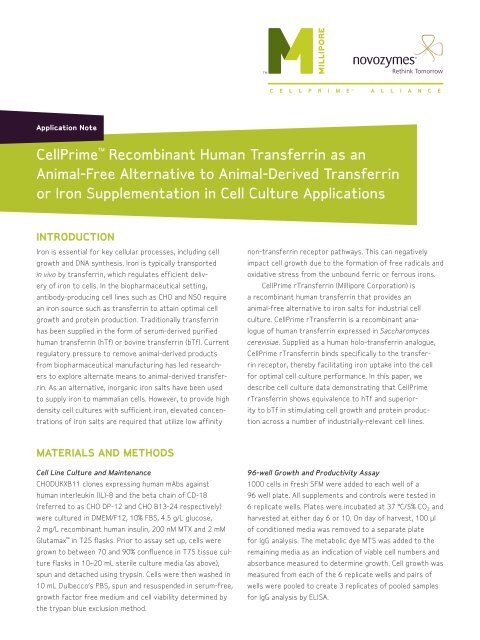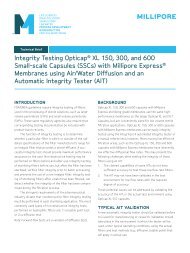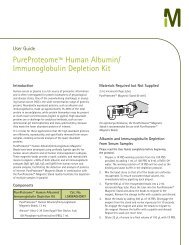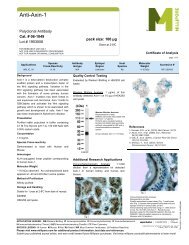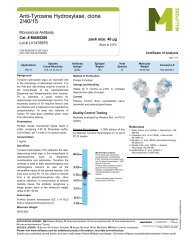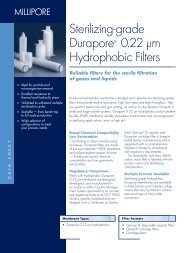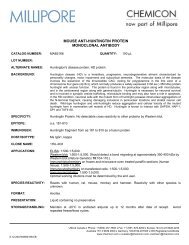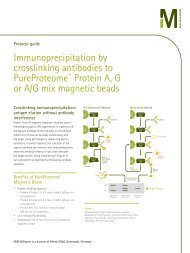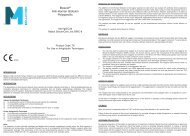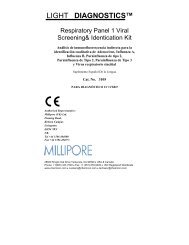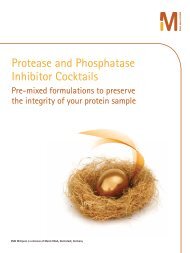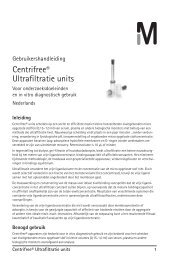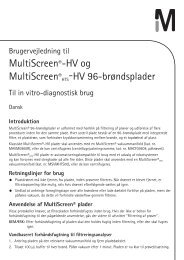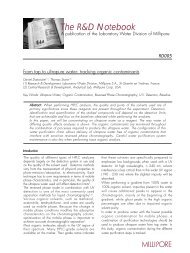CellPrime™ Recombinant Human Transferrin as an ... - Millipore
CellPrime™ Recombinant Human Transferrin as an ... - Millipore
CellPrime™ Recombinant Human Transferrin as an ... - Millipore
You also want an ePaper? Increase the reach of your titles
YUMPU automatically turns print PDFs into web optimized ePapers that Google loves.
Application note<br />
CellPrime <strong>Recombin<strong>an</strong>t</strong> <strong>Hum<strong>an</strong></strong> <strong>Tr<strong>an</strong>sferrin</strong> <strong>as</strong> <strong>an</strong><br />
Animal-Free Alternative to Animal-Derived <strong>Tr<strong>an</strong>sferrin</strong><br />
or Iron Supplementation in Cell Culture Applications<br />
introduction<br />
Iron is essential for key cellular processes, including cell<br />
growth <strong>an</strong>d DNA synthesis. Iron is typically tr<strong>an</strong>sported<br />
in vivo by tr<strong>an</strong>sferrin, which regulates efficient deliv-<br />
ery of iron to cells. In the biopharmaceutical setting,<br />
<strong>an</strong>tibody- producing cell lines such <strong>as</strong> CHO <strong>an</strong>d NS0 require<br />
<strong>an</strong> iron source such <strong>as</strong> tr<strong>an</strong>sferrin to attain optimal cell<br />
growth <strong>an</strong>d protein production. Traditionally tr<strong>an</strong>sferrin<br />
h<strong>as</strong> been supplied in the form of serum-derived purified<br />
hum<strong>an</strong> tr<strong>an</strong>sferrin (hTf) or bovine tr<strong>an</strong>sferrin (bTf). Current<br />
regulatory pressure to remove <strong>an</strong>imal-derived products<br />
from biopharmaceutical m<strong>an</strong>ufacturing h<strong>as</strong> led research-<br />
ers to explore alternate me<strong>an</strong>s to <strong>an</strong>imal-derived tr<strong>an</strong>sfer-<br />
rin. As <strong>an</strong> alternative, inorg<strong>an</strong>ic iron salts have been used<br />
to supply iron to mammali<strong>an</strong> cells. However, to provide high<br />
density cell cultures with sufficient iron, elevated concen-<br />
trations of iron salts are required that utilize low affinity<br />
MAteriAls And Methods<br />
Cell Line Culture <strong>an</strong>d Mainten<strong>an</strong>ce<br />
CHODUKXB11 clones expressing hum<strong>an</strong> mAbs against<br />
hum<strong>an</strong> interleukin (IL)-8 <strong>an</strong>d the beta chain of CD-18<br />
(referred to <strong>as</strong> CHO DP-12 <strong>an</strong>d CHO B13-24 respectively)<br />
were cultured in DMEM/F12, 10% FBS, 4.5 g/L glucose,<br />
2 mg/L recombin<strong>an</strong>t hum<strong>an</strong> insulin, 200 nM MTX <strong>an</strong>d 2 mM<br />
Glutamax in T25 fl<strong>as</strong>ks. Prior to <strong>as</strong>say set up, cells were<br />
grown to between 70 <strong>an</strong>d 90% confluence in T75 tissue cul-<br />
ture fl<strong>as</strong>ks in 10–20 mL sterile culture media (<strong>as</strong> above),<br />
spun <strong>an</strong>d detached using trypsin. Cells were then w<strong>as</strong>hed in<br />
10 mL Dulbecco’s PBS, spun <strong>an</strong>d resuspended in serum-free,<br />
growth factor free medium <strong>an</strong>d cell viability determined by<br />
the tryp<strong>an</strong> blue exclusion method.<br />
non-tr<strong>an</strong>sferrin receptor pathways. This c<strong>an</strong> negatively<br />
impact cell growth due to the formation of free radicals <strong>an</strong>d<br />
oxidative stress from the unbound ferric or ferrous irons.<br />
CellPrime r<strong>Tr<strong>an</strong>sferrin</strong> (<strong>Millipore</strong> Corporation) is<br />
a recombin<strong>an</strong>t hum<strong>an</strong> tr<strong>an</strong>sferrin that provides <strong>an</strong><br />
<strong>an</strong>imal-free alternative to iron salts for industrial cell<br />
culture. CellPrime r<strong>Tr<strong>an</strong>sferrin</strong> is a recombin<strong>an</strong>t <strong>an</strong>a-<br />
logue of hum<strong>an</strong> tr<strong>an</strong>sferrin expressed in Saccharomyces<br />
cerevisiae. Supplied <strong>as</strong> a hum<strong>an</strong> holo-tr<strong>an</strong>sferrin <strong>an</strong>alogue,<br />
CellPrime r<strong>Tr<strong>an</strong>sferrin</strong> binds specifically to the tr<strong>an</strong>sfer-<br />
rin receptor, thereby facilitating iron uptake into the cell<br />
for optimal cell culture perform<strong>an</strong>ce. In this paper, we<br />
describe cell culture data demonstrating that CellPrime<br />
r<strong>Tr<strong>an</strong>sferrin</strong> shows equivalence to hTf <strong>an</strong>d superior-<br />
ity to bTf in stimulating cell growth <strong>an</strong>d protein produc-<br />
tion across a number of industrially-relev<strong>an</strong>t cell lines.<br />
96-well Growth <strong>an</strong>d Productivity Assay<br />
1000 cells in fresh SFM were added to each well of a<br />
96 well plate. All supplements <strong>an</strong>d controls were tested in<br />
6 replicate wells. Plates were incubated at 37 °C/5% CO 2 <strong>an</strong>d<br />
harvested at either day 6 or 10. On day of harvest, 100 µl<br />
of conditioned media w<strong>as</strong> removed to a separate plate<br />
for IgG <strong>an</strong>alysis. The metabolic dye MTS w<strong>as</strong> added to the<br />
remaining media <strong>as</strong> <strong>an</strong> indication of viable cell numbers <strong>an</strong>d<br />
absorb<strong>an</strong>ce me<strong>as</strong>ured to determine growth. Cell growth w<strong>as</strong><br />
me<strong>as</strong>ured from each of the 6 replicate wells <strong>an</strong>d pairs of<br />
wells were pooled to create 3 replicates of pooled samples<br />
for IgG <strong>an</strong>alysis by ELISA.
2<br />
results<br />
CellPrime r<strong>Tr<strong>an</strong>sferrin</strong> Incre<strong>as</strong>es Growth <strong>an</strong>d Protein<br />
Production in Two CHO Cell Lines<br />
To examine the time-course of the effect of CellPrime<br />
r<strong>Tr<strong>an</strong>sferrin</strong> on CHO cell growth <strong>an</strong>d protein production, two<br />
concentrations of the supplement (1 <strong>an</strong>d 5 µg/mL) were initially<br />
tested in CHO DP-12 cells. At day 6, modest incre<strong>as</strong>es in both<br />
<br />
<br />
<br />
<br />
<br />
<br />
<br />
<br />
<br />
The ability of CellPrime r<strong>Tr<strong>an</strong>sferrin</strong> to promote cell<br />
growth w<strong>as</strong> also tested against DP-12 <strong>an</strong>d B13-24 cell lines in<br />
parallel. At harvest (Day 6), both cell lines showed <strong>an</strong> incre<strong>as</strong>e<br />
in growth (Figure 2A) <strong>an</strong>d protein production (Figure 2B) when<br />
compared to SFM. The incre<strong>as</strong>e in growth for the B13-24<br />
<strong>Hum<strong>an</strong></strong> <strong>Recombin<strong>an</strong>t</strong> <strong>an</strong>d Native <strong>Tr<strong>an</strong>sferrin</strong>s<br />
Promote Greater Growth <strong>an</strong>d Protein Production<br />
th<strong>an</strong> Bovine <strong>Tr<strong>an</strong>sferrin</strong><br />
Figure 1A<br />
<br />
The next step w<strong>as</strong> to compare the efficacy of CellPrime rTr<strong>an</strong>s-<br />
ferrin to commonly used tr<strong>an</strong>sferrin media supplements. To<br />
this end, CellPrime r<strong>Tr<strong>an</strong>sferrin</strong> w<strong>as</strong> compared to serum-<br />
derived hum<strong>an</strong> tr<strong>an</strong>sferrin (hTf) <strong>an</strong>d bovine tr<strong>an</strong>sferrin (bTf) at<br />
identical concentrations (5 µg/mL) in the CHO DP-12 cell line.<br />
<br />
<br />
<br />
growth (Figure 1A) <strong>an</strong>d protein production (Figure 1B) were<br />
observed <strong>as</strong> compared to the SFM control. By day 10, however,<br />
both concentrations of CellPrime r<strong>Tr<strong>an</strong>sferrin</strong> had incre<strong>as</strong>ed<br />
growth by > 2-fold (Figure 1A) <strong>an</strong>d incre<strong>as</strong>ed protein production<br />
by > 3-fold <strong>as</strong> compared to the SFM control (Figure 1B).<br />
<br />
<br />
<br />
<br />
<br />
<br />
<br />
<br />
Figure 1B<br />
<br />
Figure 1: CellPrime r<strong>Tr<strong>an</strong>sferrin</strong> incre<strong>as</strong>es both growth (Figure 1A) <strong>an</strong>d protein production (Figure 1B) of CHO DP-12 cells. Cells were grown in either<br />
SFM, or SFM supplemented with 1 or 5 µg/mL CellPrime r<strong>Tr<strong>an</strong>sferrin</strong> for up to 10 days.<br />
<br />
<br />
<br />
<br />
<br />
<br />
<br />
<br />
<br />
<br />
Figure 2A<br />
<br />
<br />
<br />
<br />
w<strong>as</strong> modest compared to the incre<strong>as</strong>e demonstrated by the<br />
DP-12 cells; however, it w<strong>as</strong> still a noteworthy incre<strong>as</strong>e over<br />
the SFM control. More import<strong>an</strong>tly, the protein production of<br />
both cells lines incre<strong>as</strong>ed by greater th<strong>an</strong> 2-fold compared<br />
to SFM alone at both 1 <strong>an</strong>d 5 µg/mL CellPrime r<strong>Tr<strong>an</strong>sferrin</strong>.<br />
<br />
<br />
<br />
<br />
<br />
<br />
<br />
<br />
<br />
Figure 2B<br />
<br />
Figure 2: CellPrime r<strong>Tr<strong>an</strong>sferrin</strong> incre<strong>as</strong>es both growth (Figure 2A) <strong>an</strong>d protein production (Figure 2B) of CHO DP-12 <strong>an</strong>d CHO B13-24 cells. Cells were<br />
grown in either SFM, or SFM supplemented with 1 or 5 µg/mL CellPrime r<strong>Tr<strong>an</strong>sferrin</strong> for 6 days.<br />
At day 6 <strong>an</strong>d 10 in culture, CellPrime r<strong>Tr<strong>an</strong>sferrin</strong> promoted<br />
similar incre<strong>as</strong>es in growth (Figure 3A) <strong>an</strong>d protein produc-<br />
tion (Figure 3B) <strong>as</strong> native hTf. In contr<strong>as</strong>t, bTf showed little<br />
incre<strong>as</strong>e in cell growth <strong>as</strong> compared to SFM, with signific<strong>an</strong>tly<br />
greater effects observed at day 10 compared to day 6. Similar<br />
results were observed at day 10 in culture (data not shown).<br />
This data suggests that CHO cells respond preferentially to<br />
<br />
<br />
<br />
<br />
hum<strong>an</strong> tr<strong>an</strong>sferrin in either native or recombin<strong>an</strong>t form.
Figure 3A<br />
<br />
<br />
<br />
<br />
<br />
<br />
<br />
<br />
<br />
<br />
<br />
<br />
<br />
<br />
<br />
Figure 3B<br />
<br />
<br />
Figure 3: CellPrime r<strong>Tr<strong>an</strong>sferrin</strong> <strong>an</strong>d hum<strong>an</strong> tr<strong>an</strong>sferrin (hTf) promote greater growth (Figure 3A) <strong>an</strong>d protein production (Figure 3B) of CHO DP-12 cells<br />
th<strong>an</strong> bovine tr<strong>an</strong>sferrin (bTf). Cells were grown in either SFM, or SFM supplemented with 5 µg/mL CellPrime r<strong>Tr<strong>an</strong>sferrin</strong>, hTf or bTf for up to 10 days.<br />
CellPrime r<strong>Tr<strong>an</strong>sferrin</strong> is More Effective at Promoting<br />
Growth <strong>an</strong>d Protein Production th<strong>an</strong> Iron Salts<br />
Iron salt supplementation is <strong>an</strong>other commonly used method<br />
for enh<strong>an</strong>cing CHO cell perform<strong>an</strong>ce. In this experiment, iron<br />
salts were added to a commonly used off-the-shelf medium<br />
(DMEM/F12) that already contains a nominal amount of iron.<br />
For these experiments, CellPrime r<strong>Tr<strong>an</strong>sferrin</strong> (5 µg/ml) w<strong>as</strong><br />
tested against iron salts (1.3 µM) using the same experimen-<br />
tal model <strong>as</strong> described above in CHO DP-12 (Figure 4A <strong>an</strong>d 4B)<br />
<strong>an</strong>d CHO B13-24 (Figure 5A <strong>an</strong>d 5B) cells. The results indicate<br />
that all treatments with CellPrime r<strong>Tr<strong>an</strong>sferrin</strong> performed<br />
<br />
<br />
<br />
<br />
<br />
<br />
<br />
<br />
<br />
<br />
<br />
<br />
<br />
Figure 4A<br />
<br />
<br />
<br />
<br />
<br />
<br />
<br />
<br />
<br />
<br />
<br />
<br />
<br />
<br />
<br />
<br />
<br />
<br />
<br />
<br />
<br />
<br />
<br />
<br />
<br />
<br />
Figure 4B<br />
<br />
<br />
<br />
<br />
Figure 4: CellPrime r<strong>Tr<strong>an</strong>sferrin</strong> supports greater growth <strong>an</strong>d protein production of CHO DP-12 cells th<strong>an</strong> commonly used iron salts. Cells were grown<br />
in either SFM, or SFM supplemented with CellPrime r<strong>Tr<strong>an</strong>sferrin</strong> (5 µg/mL) or <strong>an</strong> iron salt (1.3 µM) for either 6 days (Figure 4A) or 10 days (Figure 4B).<br />
<br />
<br />
<br />
<br />
<br />
<br />
<br />
<br />
<br />
<br />
<br />
<br />
<br />
Figure 5A<br />
<br />
<br />
<br />
<br />
<br />
<br />
<br />
<br />
<br />
<br />
<br />
<br />
<br />
<br />
<br />
<br />
<br />
<br />
<br />
<br />
equal to or better th<strong>an</strong>, treatments with iron salts for both<br />
growth <strong>an</strong>d protein production in either CHO clone. The<br />
incre<strong>as</strong>ed growth <strong>an</strong>d protein production were again more<br />
pronounced in the DP-12 cells th<strong>an</strong> the B13-24 cells, <strong>as</strong><br />
observed in experiments described above. These data indi-<br />
cate that CellPrime r<strong>Tr<strong>an</strong>sferrin</strong>’s benefit is derived from<br />
its biological activity <strong>as</strong> <strong>an</strong> iron carrier rather th<strong>an</strong> from the<br />
addition of iron bound to CellPrime r<strong>Tr<strong>an</strong>sferrin</strong>, since the<br />
amount of iron added via the CellPrime r<strong>Tr<strong>an</strong>sferrin</strong> is much<br />
lower th<strong>an</strong> that added to the medium by adding iron salts.<br />
<br />
<br />
<br />
<br />
<br />
<br />
<br />
<br />
<br />
<br />
<br />
Figure 5B<br />
<br />
<br />
Figure 5: CellPrime r<strong>Tr<strong>an</strong>sferrin</strong> supports greater growth <strong>an</strong>d protein production of CHO B13-24 cells th<strong>an</strong> commonly used iron salts. Cells were grown<br />
in either SFM, or SFM supplemented with CellPrime r<strong>Tr<strong>an</strong>sferrin</strong> (5 µg/mL) or <strong>an</strong> iron salt (1.3 µM) for either 6 days (Figure 5A) or 10 days (Figure 5B).<br />
<br />
<br />
<br />
<br />
<br />
<br />
<br />
<br />
<br />
<br />
<br />
<br />
<br />
<br />
<br />
<br />
<br />
<br />
<br />
<br />
<br />
<br />
<br />
3
discussion<br />
The biopharmaceutical industry is const<strong>an</strong>tly striving<br />
for optimal cell growth <strong>an</strong>d protein production in their<br />
upstream m<strong>an</strong>ufacturing process, while maintaining product/<br />
process consistency <strong>an</strong>d compli<strong>an</strong>ce. Historically, the num-<br />
ber of <strong>an</strong>imal free, defined protein supplements available<br />
for use <strong>as</strong> industrial cell culture supplements h<strong>as</strong> been lim-<br />
ited. The introduction of CellPrime r<strong>Tr<strong>an</strong>sferrin</strong> provides <strong>an</strong><br />
<strong>an</strong>imal-free alternative to iron salt supplementation that per-<br />
mits biological, not chemical, iron supplementation in cell<br />
culture media. This is <strong>an</strong> import<strong>an</strong>t distinction, <strong>as</strong> the data<br />
comparing the effect of CellPrime r<strong>Tr<strong>an</strong>sferrin</strong> to iron salts<br />
suggest that biological delivery of iron promotes growth<br />
<strong>an</strong>d protein production to a degree not seen with iron salts<br />
alone. The data detailed in this paper also demonstrate that<br />
CellPrime r<strong>Tr<strong>an</strong>sferrin</strong> supports cell growth <strong>an</strong>d protein<br />
to PlAce An order or receive<br />
technicAl AssistAnce<br />
For additional information call your nearest <strong>Millipore</strong> office:<br />
In the U.S. <strong>an</strong>d C<strong>an</strong>ada, call toll-free<br />
1-800-MILLIPORE (1-800-645-5476)<br />
In the U.S., C<strong>an</strong>ada <strong>an</strong>d Puerto Rico, fax orders to<br />
1-800-MILLIFX (1-800-645-5439)<br />
Outside of North America contact your local office. To find the<br />
office nearest you: www.millipore.com/offices<br />
Internet: www.millipore.com<br />
Technical Service: www.millipore.com/techservice<br />
www.millipore.com/offices<br />
ADVANCING LIFE SCIENCE TOGETHER <br />
Research. Development. Production.<br />
production equivalent to hTf, <strong>an</strong>d superior to bTf, indicat-<br />
ing that supplement species choice c<strong>an</strong> subst<strong>an</strong>tially affect<br />
cell culture perform<strong>an</strong>ce <strong>as</strong> well. The low concentration of<br />
CellPrime r<strong>Tr<strong>an</strong>sferrin</strong> required to achieve incre<strong>as</strong>ed cell per-<br />
form<strong>an</strong>ce makes this a cost-effective option for providing<br />
optimal iron supplementation to cells.<br />
In summary, CellPrime r<strong>Tr<strong>an</strong>sferrin</strong> provides a superior<br />
alternative to commonly used bovine-derived tr<strong>an</strong>sferrin or<br />
iron supplements in cell culture by eliminating the use of <strong>an</strong>i-<br />
mal-derived components while enh<strong>an</strong>cing cell perform<strong>an</strong>ce.<br />
Additional experiments are pl<strong>an</strong>ned in customer-relev<strong>an</strong>t<br />
<strong>as</strong>says on a larger scale (i.e., shake fl<strong>as</strong>k <strong>an</strong>d bioreactor scale)<br />
in cells grown in completely serum-free conditions to verify<br />
the findings of this study.<br />
<strong>Millipore</strong> is a registered trademark of <strong>Millipore</strong> Corporation.<br />
The M mark <strong>an</strong>d Adv<strong>an</strong>cing Life Science Together are trademarks of <strong>Millipore</strong> Corporation.<br />
CellPrime is a trademark of <strong>Millipore</strong> Corporation <strong>an</strong>d Novozymes.<br />
Novozymes is a registered trademark of Novozymes A/S.<br />
Glutamax is a trademark of Invitrogen Corporation.<br />
Lit No. AN1257EN00 Rev. - 05/08 Printed in U.S.A. UP SBU-08-00276<br />
© 2008 <strong>Millipore</strong> Corporation, Billerica, MA 01821 U.S.A. All rights reserved.


